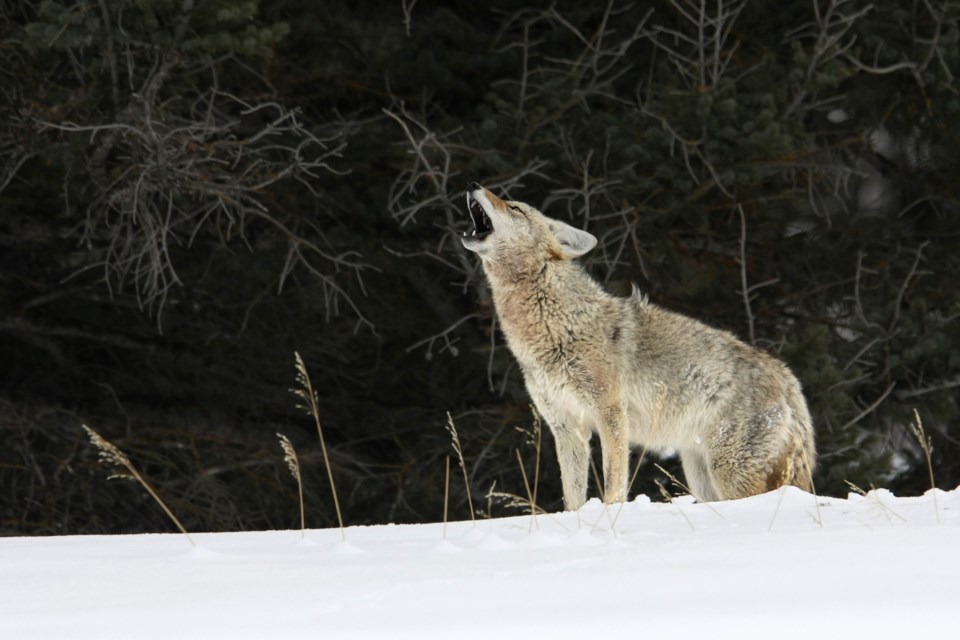Newmarket resident Shelagh Kane got a concerning call from her daughter last week: coyotes were causing a problem.
Kane recounted her daughter’s experience with a coyote approaching her and her friends, stealing a mitten, then chasing her daughter and friends in the Fairy Lake area after they dropped their toboggans and ran. Kane came to pick them up and try to retrieve the items.
As Kane went to grab the toboggans, the coyote returned. The coyote approached her daughter, and Kane said she ran in front of the coyote, screaming out “no, no,” to try to get the coyote to back off. The coyote did pause, and Kane said they were able to separate from the animal.
“I felt ill-prepared because I wasn’t 100 per cent sure what to do when I came face to face with a coyote,” Kane said. “I hadn’t expected that to happen, that close proximity and I felt really scared as a parent, because I felt it was my job to make sure the girls didn’t get hurt … Had it chosen to be aggressive, I would have been in really big trouble, essentially I would have had to fight it off. But thankfully, it wasn’t really showing signs of aggression, just a lot of signs of familiarity."
Newmarket residents have been expressing concerns on social media about coyotes approaching closely in recent days, particularly in the Fairy Lake area. The municipality said it is aware of the coyote frequenting the area, and staff is conducting "aversion conditioning" when appropriate to change coyote behaviour.
Kane's account of the encounter posted on Facebook received more than 100 comments. She said she appreciated the support and some of the educational responses. But she said she hopes action is taken and floated relocation as a possibility.
“I won’t be walking (near) Fairy Lake anymore in the evening time or at dusk,” Kane said. “I’m a little bit sketched out.”
Town animal services supervisor Jacob Brewer said the municipality is using aversion conditioning on the coyote in the Fairy Lake area. He said deterrents such as loud noises, gestures and voices can compel wildlife to move along and teach a behavioural instinct to stay away from people.
“Generally, coyotes don’t pose a threat to humans as they are typically shy and would prefer to avoid any sort of confrontation,” Brewer said. “By taking precautions, we can try to prevent any unwanted encounters. This is an adopted approach by many municipalities.”
The town does not trap, euthanize or relocate coyotes. Brewer said trapping coyotes is difficult and the associated traps could pose a threat to pets and humans.
Instead, the town focuses on education. Brewer said removing food attractants, keeping pets on leashes and discouraging wildlife from approaching can help keep them at a safe distance.
“We encourage residents to review what to do if you see a coyote and to talk about it with your family,” Brewer said. “Often, our natural instinct is to run – but you should never run or turn your back on a coyote. If you are approached, stay calm and back away slowly. If threatened, use loud noises, whistles and personal alarm devices as a deterrent.”
Local biologist Aileen Barclay said she is aware of this coyote and that it was being fed by a human, which has now stopped. She said people often get worried about coyotes this time of year. But she said close coyote encounters are ultimately a human-caused problem, usually due to food sources.
Feeding a coyote “is the worst thing you can do,” Barclay said, “because they associate people with food.”
But she said this coyote still has some fear of humans, and she herself was able to wave it off by approaching. She said coyotes are not likely to bite, with off-leash dog biting incidents being far more common and worrisome.
Barclay said relocation is disallowed and ineffective. Culling coyotes is also a poor method, with coyote populations generally able to bounce back quickly, she said. Aversion conditioning is the best method for coyote control, she added.
“Coyotes aren’t out to eat us,” she said. “They are thriving in urban areas, this isn’t about habitat loss and us building over their homes. They thrive in urban areas because of great food sources, naturally, like rats … All the things we complain about, they will help control.”
The Town of Aurora recently had a spike in coyote sightings, prompting an information session in the community at the end of October.
Coyote encounters are appearing in other parts of town. Local Jackie Morley Soares also had a close encounter in the Huron Heights Drive area. She said she was talking with a neighbour when a coyote approached them just across the street, staring at them and unperturbed by their efforts to shout at it and shoo it away.
Soares said she is not sure what can be done regarding coyotes getting too close to humans, but there should be a consultation to figure out a solution.
“This was literally out in the street, and there’s three schools in walking distance,” she said. “It’s unnerving. That it’s that bizarre. They’re not scared of us anymore.”



